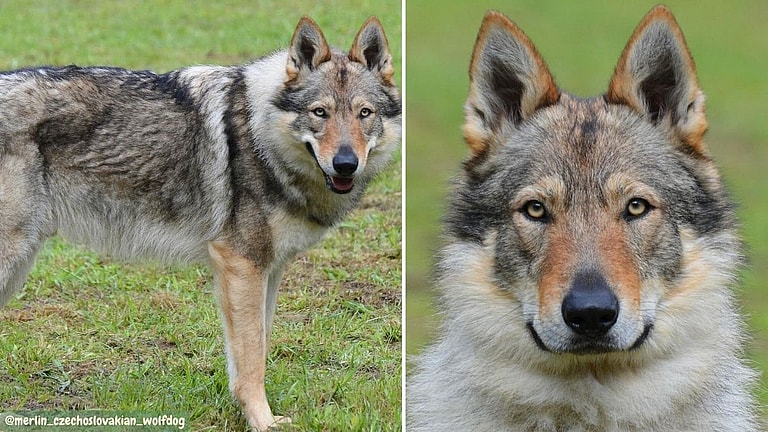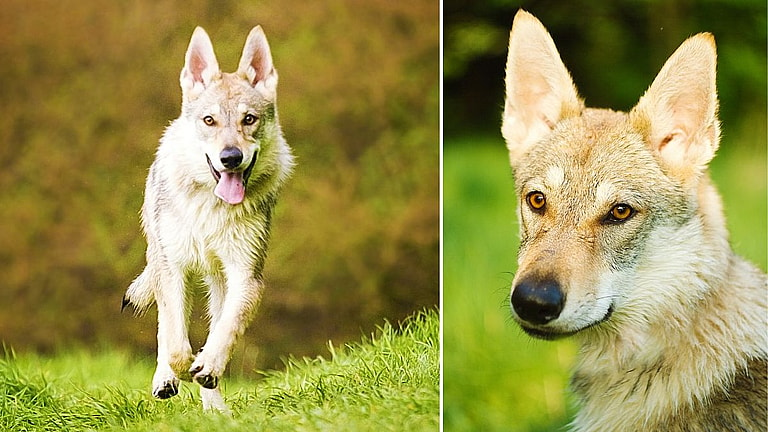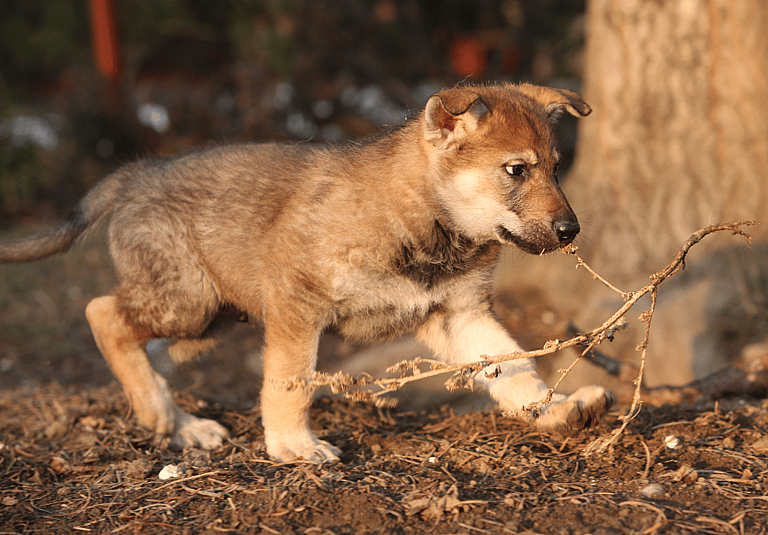Are Czechoslovakian Wolfdogs a Hybrid Or a True Domestic Dog Breed?
Lieutenant Colonel Karel Hartl, a retired Czechoslovakian officer and zootechnician engineer, bred the very first Czechoslovakian Wolfdog in 1958 while serving as Chief of Service Cynology. Cynology is the study of all things relating to canines and domestic dogs, and Hartl was already well respected by his peers—the development of the Czech Vlcak dog, however, would put him on the map.

Collaborating with associate cynologist Major Frantisek Rosik—affectionately nicknamed “Dedo” or “granddad” by fellow dog enthusiasts—Hartl conducted a breeding experiment to create a “superior border guard dog that has the hearing, scenting, sight, weather resistance and endurance of the wolf.” [1]
Hartl and Rosik used forty German Shepherds for their experiments and cross-bred them with four carefully chosen Carpathian wolves named Brita, Argo, Sarik, and Lejdy.

The crossing of a German Shepherd dog with a Carpathian wolf produces viable offspring because Carpathian wolves (Canis lupus lupus)—also called Eurasian wolves—and domestic dogs (Canis lupus familiaris) are both subspecies of the Gray wolf (Canis lupus).
The first few generations of Czech Vlcak dogs were high and mid-content wolf dogs and Hartl and Rosik were lauded for the success of their experiment. By 1989, the CSV dogs were given provisional recognition by the Federation Cynologique Internationale—the largest international federation of kennel clubs—and gained fans worldwide who were keen to help further the breed.
So what about today’s Czechoslovakian Wolfdogs? Do they still have wolf DNA in their genome, or are they fully domesticated dogs?
Are Czechoslovakian Wolfdogs Genetically Part Wolf?
Organizations like the Czechoslovakian Vlciak Club of America hold firm to the claim that Czech Wolfdogs are “not wolf hybrids,” but DNA tests and genetic studies tell a different story.
This study on the genomic makeup of the Czechoslovakian Wolfdog from BMC Genomics identified “wolf components” of around 25% or more “in the genome of the [12 unrelated] CDWs.” While there is no doubt that Czech Wolfdogs carry wolf DNA, “the key wolf-like genes [identified in the study] were mainly related to body size and shape traits, which could explain the overall morphological similarity of CWDs with wolves.”
Other studies confirm that while Czech Wolfdogs have wolf DNA, they retain a higher proportion of domestic canine DNA in their genome overall.
So, yes, Czech Wolfdogs have wolf ancestors and many have detectable wolf DNA, but they aren’t as “wolfy” as the Wolfdogs we most commonly see in North America, which typically have very recent wolf ancestry. While Czech Wolfdogs are a relatively recent mix of German Shepherds and Carpathian wolves, the purposeful backcrossing has helped to make Czech Wolfdogs more genetically similar to domestic canines.
Meet 5 Czechoslovakian Wolfdogs From Instagram
Are you itching to meet some Czechoslovakian Wolfdogs? Get ready, I’m about to introduce you to a handful! One of the coolest things about Czech Wolfdogs is how well-documented their breeding history has been. Almost all Czech Wolfdogs can be found listed on an official wolfdog database that features ancestry, genetic details, and even dog show rankings for each dog.
1. Branka

Branka is a Czech Wolfdog with a hiking hyper-fixation who lives with her human, a Dalmatian sibling (pictured above), and even a cat! Bred by the vom Kaskadewolf kennel in Germany, Branka has a theoretical wolfblood percentage of 28% and is the direct descendent of the first Eurasian wolf crossed with a German Shepherd, Brita.
2. Dakota

Wondering what Czechoslovakian Wolfdog puppies look like? Check out Dakota when she was just an itty-bitty pup! Dakota is a year old now, and it’s amazing how much she has grown up.
3. Celeste & Björk

Celeste and Björk were both bred at Amyfield’s Kennel in Sweden, where they still reside! Both Celeste and Björk are 28.5% theoretical wolfblood Czech Wolfdogs, and they’re excellent sled dogs who love to run with their humans being pulled behind in the winter months.
4. Merlin

Bred by the od Úhoště kennel in the Czech Republic, Merlin is a 28.3% wolfblood Czech Wolfdog and a direct descendent of Brita, the first Eurasian wolf used in the experiments that created the Czech Wolfdog.
Czechoslovakian Vlcak Dog Basic Info
The Czechoslovakian Wolfdog is also called the Czechoslovakian Vlcak (Československý vlčák in Czech) or the Czechoslovakian Vlciak (Československý vlčiak in Slovak.) A highly standardized wolfdog breed, the Czech Vlcak is recognized as a national breed in the Czech Republic alongside the Cesky Terrier and several other interesting breeds.
Like other Wolfdogs, the Czech Vlcak’s aesthetics are often the focus of potential owners, but let me warn you that these dogs are not for inexperienced or first-time owners. Although the Czech Wolfdog has been standardized and would at most be considered low-content wolfdogs, their behavioral and care needs are very different from the average domestic dog.
Czechoslovakian Wolfdog Temperament
The very first Czechoslovakian Wolfdog breeders aimed to enhance the qualities of the dog most commonly used for border patrol: the German Shepherd. Intelligent and active, the Czech Wolfdogs need more daily exercise and mental stimulation than most other dog breeds.
Favored by people who enjoy canine sports like trail work or outdoor enthusiasts who like to bike, run, or hike long-distance, Czech Wolfdogs are impossible to tire out with a basic walk around the block or a trip to the dog park. During endurance tests, Czech Wolfdogs outperform most other dogs, and some have even run upwards of 80–100 km (50–62 miles) in just eight hours. Czech Wolfdogs are superior runners, and the Czechoslovakian Vlcak Club of America describes them as “tenacious canterers!”
Loyal and curious, Czech Vlcak dogs make excellent search and rescue dogs and are frequently used as multi-purpose working dogs in Europe. Though they can excel in obedience, Czech Wolfdogs can be easily distracted by their senses and high prey drive. Considered hard to train and skittish, Czech Wolfdogs have little of the human-focused biddability of most domestic dogs. Czech Wolfdogs need an experienced handler who can keep them on task and knows how to channel their high stamina and endurance into healthy avenues.

“Stubborn isn’t really the way I’d describe [Czech Wolfdogs]. They are independent thinkers and extremely intelligent, [and] they need sufficient motivation and a level of trust in their handlers to want to perform at all,” says a Czech Wolfdog owner, sharing his experience with the breed in a comment on Reddit. “[Czech Wolfdogs] grow bored of repetition very quickly…they’re smart and catch on quickly and they’re athletic and love to be involved, but it has to be fun for them to make it [worthwhile]. [Czech Wolfdogs] can also be somewhat defensive and sensitive, and usually do not take well to aversive methods, especially compared to other working breeds.”
Some Czech Wolfdogs can be dog-selective, and many are same-sex aggressive once they hit maturity, so a home with no other dogs or a dog of the opposite sex is best. Not recommended for homes with small animals or very young children, Czech Wolfdogs in homes with respectful older children and adults who create firm boundaries can become fearless and courageous protectors. Still, this breed is unlikely to behave like your average companion animal.
Czechoslovakian Wolfdog Size
Czechoslovakian Wolfdogs are medium dogs standing 25–23.5 inches tall and weighing in at 44–57+ pounds.
Czechoslovakian Wolfdog Health
Czech Wolfdog breeders should perform extensive genetic testing to avoid introducing genetic diseases and abnormalities to their bloodlines. An uncommon breed with a recent genetic history, there isn’t a large pool of Czech Wolfdogs to choose from, and inbreeding is a relatively high risk.
Some common health issues to be aware of if you own a Czech Vlcak include:
- Dental disease
- Eye and vision problems (e.g. lens luxation)
- Joint problems (e.g. elbow and hip dysplasia)
- Back and spine issues (e.g. degenerative myelopathy)
- Heart disease
- Pituitary dwarfism (growth hormone deficiency)
Where To Find Czechoslovakian Vlcak Puppies For Sale

Remember that very few people have the right combination of experience, resources, and time to raise a Czech Wolfdog puppy. If you think you have all the right qualities, your next hurdle will be finding a Czechoslovakian Vlcak for sale, USA or abroad.
It is no easy task to find a Czechoslovakian Wolfdog for sale. USA breeders are few and far between, and there are currently only four Czechoslovakian Vlcak breeders in the US affiliated with the Czechoslovakian Vlciak Club of America. If you live in Europe or can get to the Czech Republic, finding a Czech Vlcak for sale from an ethical breeder will be easier, but you may run into issues trying to import the dog.
If you can’t find a Czech Wolfdog breeder or a Czech Wolfdog for sale (USA in the search bar can help!) in your area, consider joining online forums or groups of Czech Wolfdog owners and breeders. By getting to know people in the community, you can learn more about the breed and whether it’s right for you, and get connections to Vlcak dog breeders with upcoming litters.
Czech Wolf Dog FAQ
You probably have more questions, and I don’t blame you! Here are some quick answers to some of the most common queries about the Czech Wolf Dog.
Are Czechoslovakian Wolf Dogs registered with the American Kennel Club?
Yes! Czech Wolfdogs are recognized by the AKC, eligible to participate in dog shows, and recognized by most international kennel clubs.
Are Czechoslovakian Wolfdogs legal to own in the United States?
There is no federal law prohibiting wolfdog ownership, but there are states that ban or restrict private ownership of wolf-dog hybrids. Some Czechoslovakian Wolfdogs may not be considered true wolfdogs but domestic dogs. Depending on DNA testing results, some states and municipalities may impose restrictions on Czech Wolfdogs, so do research and contact your local authorities before finding a Czech Vlcak dog for sale. Some Czech Wolf Dog breeders may ask where you live because of these restrictions and may have insight on local laws regarding this breed.
Do Czechoslovakian Wolfdogs shed?
Yes, this breed sheds heavily. Czech Wolfdogs have a thick double coat that sheds year-round. They also “blow” their coats during seasonal changes, dropping excess dead undercoat to be replaced for the changing weather.
How long do Czech Wolfdogs live?
The average lifespan of a Czechoslovakian Wolfdog is 12–16 years.
How much do Czechoslovakian Wolfdog puppies cost?
The average asking price for a Czech Wolf Dog for sale is highly varied and depends largely on where you live and whether you want a puppy or an adult. In the U.S., where there are very few breeders, prices for Czech Wolfdogs range from around $2,000–$8,000 as reported by owners of this breed.
Remember that if you see a Czechoslovakian Wolf Dog for sale you should thoroughly research the breeder before contacting them or becoming in any way affiliated. Scammers and unethical breeders will try to pass off non-wolfdogs or common Gray Wolf hybrids as Czechoslovakian Wolfdogs.



